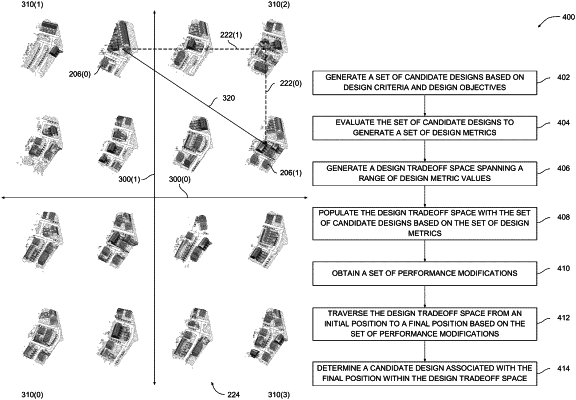| CPC G06F 30/13 (2020.01) [G06N 3/126 (2013.01); G06Q 10/06313 (2013.01); G06Q 40/12 (2013.12); G06Q 50/165 (2013.01); G06F 3/04815 (2013.01); G06F 3/04847 (2013.01); G06F 2111/02 (2020.01); G06F 2111/04 (2020.01); G06F 2111/06 (2020.01); G06F 2111/20 (2020.01); G06T 15/005 (2013.01); G06T 17/05 (2013.01)] | 20 Claims |

|
1. A computer-implemented method for generating designs for an urban design project via a computer-aided design (CAD) application, the method comprising:
generating, via a geometry engine included in the CAD application, a plurality of candidate designs based on a set of design criteria and a set of competing design objectives;
generating, via a tradeoff engine included in the CAD application, a design tradeoff space that includes the plurality of candidate designs having values associated with multiple dimensions within the design tradeoff space based on different sets of design metrics, wherein each design metric included in the different sets of design metrics quantifies a degree to which a corresponding design objective is met, and wherein a first graphical user interface can be used to visualize two dimensions of the multiple dimensions at a given time;
receiving a first set of performance modifications specifying one or more changes to one or more of the degrees to which one or more design objectives included in the set of competing design objectives are met;
traversing, via the tradeoff engine, the design tradeoff space from a first position in the design tradeoff space associated with a first set of degrees to which the one or more design objectives are met for a first candidate design included in the plurality of candidate designs to a second position in the design tradeoff space associated with a second set of degrees to which the one or more design objectives are met based on the first set of performance modifications;
generating a second candidate design not included in the plurality of candidate designs based on the second position in the tradeoff space;
generating, via the tradeoff engine, a first combined metric for the first candidate design based on a first set of design metrics for the first candidate design; and
generating, via the tradeoff engine, a second combined metric for the second candidate design based on a second set of design metrics for the second candidate design, wherein the second combined metric is greater than the first combined metric, thereby indicating that the second candidate design is a higher ranked design than the first candidate design.
|